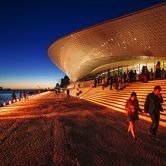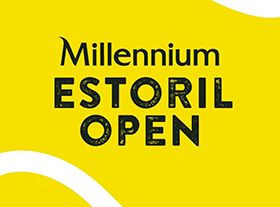Contemporary architecture in the streets of Lisbon
Over the course of two days, walk the streets of Lisbon exploring the architectural landmarks of the 19th, 20th and early 21th centuries.
The route starts in Baixa, in the Rua do Ouro, where you can see the neogothic Santa Justa lift. The elevator, which was inaugurated in 1902, was designed by the engineer Raoul Mesnier de Ponsard. Enjoy its iron architecture as you ascend to Chiado, an upmarket area of the city which was partially rebuilt under the design of architect Álvaro Siza Vieira, following the fire in 1988. As you go up Rua Garrett towards Largo de Camões, you come across the statue of the poet Fernando Pessoa sitting in front of the café A Brasileira. This Art Deco style café, which opened in 1905, is considered the foremost museum of modern art in Lisbon, because of the works that modernist authors, frequent visitors to the cafe, offered to decorate the walls. The characteristic façade of this establishment was designed by the architect Norte Júnior.
Go back down Rua do Carmo past Dom Pedro IV Square, also known as Praça do Rossio, and head towards Praça dos Restauradores, and take a look at the Eden Cinema, Portugal's Art Deco masterpiece, designed in the 1930s by Cassiano Branco. In the late twentieth century it was transformed into a hotel, preserving part of the facade. In front of the Eden Building, descend a small slope to the street of Portas de Santo Antão. Here you will find Casa do Alentejo, a former palace in the Moorish style possibly built at the end of the 17th century, but which underwent profound changes in the early 20th century.
Go up Avenida da Liberdade which has several buildings of interest such as the São Jorge Cinema, designed by architect Fernando Silva and inaugurated in 1950; the Tivoli Theatre designed by architect Raul Lino and inaugurated in 1924 or the former headquarters the Diário de Notícias by architect Pardal Monteiro. This building won the Valmor Prize in 1940 and was the first architectural work designed from scratch for a newspaper in Portugal.
The Torres das Amoreiras, symbols of the architecture of the 1980s, are at the top of Avenida Engenheiro Duarte Pacheco. The towers are considered to be one of the major symbols of the postmodernist period of architecture in Portugal and were designed by architect Tomás Taveira.
We propose that from here you head towards the Tagus River. In Alcântara, you can admire the Oriente Museum, the former salt cod warehouse, and the LX Factory, a former industrial complex that now hosts many creative companies in advertising, fashion, multimedia and art. We also recommend a visit to the Docks, where decommissioned warehouses gave way to restaurants, bars and nightclubs. Do not miss Pilar Sete, an attraction that offers a sensory experience on the construction of the 25 de Abril bridge.
Heading towards Belém, enjoy the MAAT - Museum of Art, Architecture and Technology, designed by the firm of the British architect Amanda Levete, and the new Coach Museum designed by architect Paulo Mendes da Rocha. You can then take a break at Belém Cultural Centre, an emblematic work of the last decade of the 20th century, located next to the Jerónimos Monastery. You can also enjoy the Champalimaud Foundation building, designed by architect Charles Correa, which houses a clinic and a health research centre. At Algés you can admire the Maritime Control Tower designed by architect Gonçalo Byrne. 
Maat © Stock Photos Art
Start your second day at the Cruise Terminal designed by architect Carrilho da Graça and then head towards Parque das Nações. This former industrial area was completely regenerated for the 1998 Universal Exposition, and hosts works that were kept for posterity such as the Pavilion of Portugal, with its impressive design by Siza Vieira, Pavilion of Knowledge by Carrilho da Graça, Peter Chermayeff's Oceanarium and Santiago Calatrava's Oriente Station. Observe also the Vasco da Gama Bridge inaugurated in 1998, with a total length of over 12 km.
Return to the centre of Lisbon and see an area built in the mid-twentieth century and then called “Avenidas Novas”. Visit the São João de Deus Church with the nearby monumental complex formed by Alameda D. Afonso Henriques and the Instituto Superior Técnico by Pardal Monteiro. You can see other works by this architect, such as the National Library and the Church of Our Lady of Fatima, with its wonderful stained glass windows by Almada Negreiros.
In the evening visit the Calouste Gulbenkian Foundation, a large cultural and leisure space built in the 1960s. The building is magnificent and you can visit an exhibition, watch a show or simply stroll in the lovely gardens, designed by landscape architect Gonçalo Ribeiro Teles, an authentic oasis in the middle of the city's bustle.






 Explore
Explore 
 Remember and Share
Remember and Share 


